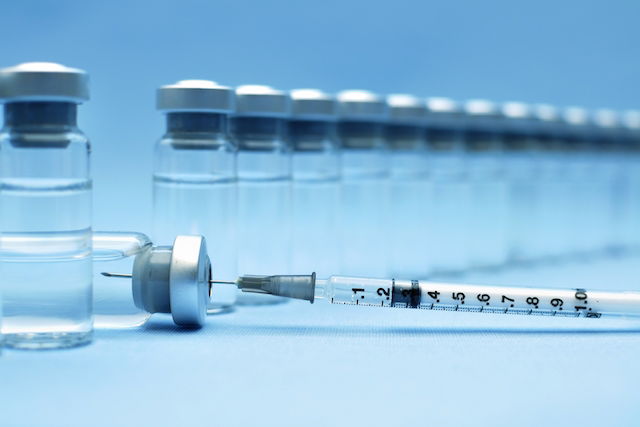Insulin is a hormone that is naturally produced by the body to regulate blood sugars. However, people with inadequate amounts of insulin or insulin with reduced sensitivity may need to use synthetic and injectable insulin.
There are many types of synthetic insulin available that imitate the natural action of insulin at any point of the day. They can be injected daily in the skin with needles, pens or small specialized pumps.
Synthetic insulin helps to normalize blood sugar levels and allows diabetics to maintain and healthy life without complications. However, its use should be prescribed by a doctor, as dosing depends on each person's necessities.

What are the different types of insulin available?
The main types of insulin vary with the action duration and the moment when they should be injected:
1. Rapid-acting insulin
Rapid-acting insulin has an almost immediate action, about 10 to 15 minutes after injection. It should be administered right before a meal. Within this category, you can find lispro, aspartic and glulisine insulin, which should be prescribed by a family doctor or endocrinologist.
This type of insulin can be purchased under the brand names NovoRapid, Aspart or Humalog.
2. Inhaled short-acting insulin
Inhaled insulin is made of insulin microspheres which can be used by adult diabetics. The spheres are quickly absorbed and act within 10 to 15 minutes of inhalation. This type insulin is contraindicated for those who smoke or with those with pulmonary diseases like COPD.
This insulin is available as a single-dose use which can vary in doses. It is recommended for use prior to meals. This type of insulin can be found under the brand name Afrezza.
3. Regular or short-acting insulin
This type of insulin has an effect 30 minutes after injection and can last for 3 to 6 hours. The doctor may prescribe regular or short-acting insulin in cases of surgery or acute infections.
This type if insulin can be found under the brand names Apidra, Novolin R, Humulin R or Actrapid.
4. Intermediate-acting insulin
Intermediate-acting insulin is a basal insulin that is used to maintain insulin levels constant in the blood for 12 to 18 hours. The doctor will typically advise two daily injections to maintain its effect throughout the body.
This insulin can be found under the brand names Humulin N ou Humulin NPH, Densulin N, Insulex N, Novolin N, Insulatard or Insuman.
5. Long-acting insulin
This type of insulin is slowly and continuously released over 24 hours so that insulin levels remain constant to imitate natural insulin throughout the day. Some types of long-acting insulin are glarfin, determir and degludec, which are prescribed by a doctor. It may be indicated for pregnant women and other particular populations.
Long-acting insulin can be found under the brand name Lantus.
6. Combined insulin
Combined insulin contain a mix of rapid or short-acting insulin with intermediate-acting insulin. Thi eliminates the need to use different vials of insulin.
Combined insulin can be be found under the brand names Humalog Mix 75/25 or Humulin 30/70
7. Ultra-long-acting insulin
Ultra-long-acting insulin can act for up to 36 hours and guarantees the most convenience, as less injections per day are needed.
This type of insulin can be found under the brand name Tresiba.
Insulin characteristics
The characteristics that differentiate the various types of insulin include:
The start time of insulin refers to the time insulin takes to take effect in the body after administration, while the peak is when insulin reaches its maximum potential in the body.
Some diabetics may need prescriptions for rapid-acting, ultra-rapid -acting, and intermediate acting insulin, also known as combined insulin (or Humulin 70/30 or Humalog Mix). It is normally recommended to reduce the number of injections per day day, especially in older adults or patients with motor or visual problems. The start, duration and peak of action depends on the insulin used in the mixture. It is generally used 2 to 3 times per day.
Insulin can be inserted with a specialized pen or injection, or an insulin pump. This is a small electronic device that is connected to the body for 24 hours. It allows for better control of blood sugar levels, and can be used by people of all ages (particularly those with type 1 diabetes).
Learn more about the diabetes medication your doctor can prescribe to manage this condition.
How to inject insulin
For any type of insulin to work, it is essential to inject it correctly, following these steps:
- Pinch a small area of skin, so that the insulin is absorbed in the subcutaneous layer.
- Insert the needle, perpendicular to the skin and inject the medication
- Swap injection sites, alternating between the back of the arm, the thigh and the belly to prevent bruising and lipohypertrophy.
In addition, it is also important to store insulin correctly. It can be stored in the fridge before opening. Once opened, it should be kept from direct sun and heat and used within one month. Read more about how to inject insulin safely at home.






























